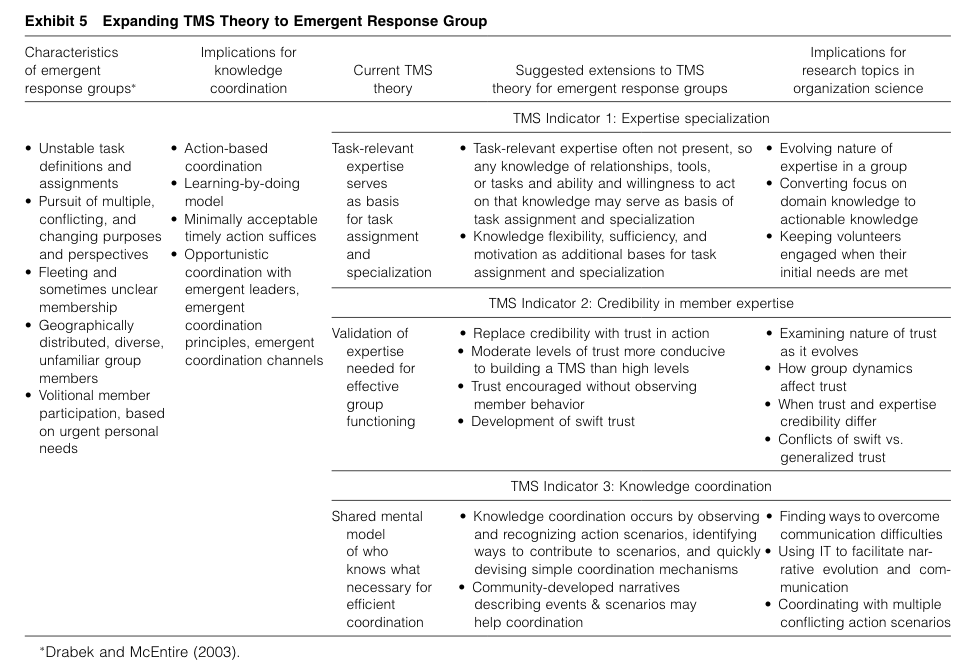Our extensions also have implications for theories ontrust.
Bookmarked section for later consideration of proposal studies on how time interacts with trust in time- and safety-critical social coordination.
Our extensions also have implications for theories ontrust.
Bookmarked section for later consideration of proposal studies on how time interacts with trust in time- and safety-critical social coordination.
Therefore, training should focus on learning how toquickly recognize volunteers’ volition in participating inan emergent group, the tasks they might engage in, andthe support they might need to carry out those tasks.Such training could also help people to recognize thebenefits and dangers of generalized trust. It could alsohelp people to quickly evolve a coordination mecha-nism that does not rely on what people know, but oncompiling and communicating a narrative of the actionsthat volunteers take, so that others are able to assess forthemselves what actions they could take to help.
Majchrzak et al continue to suggest that emergent response training could reconceptualize a new role for emergency management professionals, aside from the default coordination/management. Further, they suggest that citizens could be trained to participate.
ur examination suggests that by expandingthe context in which TMS theory is applied to includeemergent response groups, insights can be gained intotheir internal dynamics. The three indicators of the levelof development of a TMS provide a useful frameworkfor organizing these insights in the exhibit.

The urgency of time may make it too onerous forthe extra effort of articulating actions as they are beingperformed, yet most emergency response requires somecommunication.
Interaction of time (tempo/pace) and breakdowns in articulation work.
Explicitly articulated narratives mayalso make clearer that multiple sequences of actions maybe occurring simultaneously, thus resolving role conflictsby allowing multiple ways to accomplish a task
Evokes Schmidt and Bannon's articulation work in CSCW.
Emergent response groups may also use a mechanismof creating a community narrative (Boland and Tenkasi1995), which is a running narrative of the actions takenand not taken, the decisions made, and the theories inuse. Narratives do not represent a single shared under-standing of a domain; rather they represent the mul-tiplicity of events and actions a community is taking,as members are taking them. Narratives may be articu-lated explicitly or understood implicitly.
SBTF after-action report, as an example. But who is the audience for this narrative?
Whenemergent response groups first come together, membersare likely not to ask one another about who knows what;instead, they are likely to ask about what is knownabout the situation and about the actions taken thus far(Dyer and Shafer 2003, Hale et al. 2005). The cogni-tive structure that they develop for the group centersnot around people, but on action-based scenarios thateither have been or might be carried out. These scenariosinclude decisions, actions, knowledge, events, and feed-back (Vera and Crossan 2005).
Suggested extensions for TMS theory:
"1. Tailor the Role of Expertise"
"2. "Replacing Credibility in Expertise with Trust Through Action"
"3. "Coordinating Knowledge Processes Without a Shared Metastructure"
On the surface, the lack of sta-ble membership suggests that a shared mental modelmay not be viable or even desired in emergent responsegroups. Time may be too precious to seek consensus onevents and actions, and agreements may make the groupless flexible to accommodate to changing inputs.
Evokes pluritemporal concerns about tempo, pace and synchronization.
hus, we believe challenges occur in all three indica-tors of the level of development of a TMS—expertisespecialization, credibility, and expertise coordination—requiring a need to consider extending theorizing abouteach indicator for emergent response groups.
Ways to extend TMS to emergent groups:
"1. Reconceptualize the Role of Expertise Specialization as a Basis for Task Assignment"
"2. Assessing Credibility in Emergent Response Groups"
"3. Expertise Coordination in Emergent Response Groups"
These extensions evoke boundary objects and invisibility
Moreland and Argote(2003) suggest that the dynamic conditions under whichthese groups form and work together are likely to havenegative effects on the development of transactive mem-ory.
Are there workflow or technology breakdowns that could help ameliorate the negative effects?
Research on TMS has identified three indicators of thelevel of development of a TMS (Lewis 2003, Morelandand Argote 2003):1.Memory (or expertise) specialization:the tendencyfor groups to delegate responsibility and to specialize indifferent aspects of the task;2.Credibility:beliefs about the reliability of mem-bers’ expertise; and3.Task (or expertise) coordination:the ability of teammembers to coordinate their work efficiently based ontheir knowledge of who knows what in the group.The greater the presence of each indicator, the more de-veloped the TMS and the more valuable the TMS is forefficiently coordinating the actions of group members.
Three indicators of the level of sophistication of the system:
• Memory specialization (think trauma/hospital care CSCW studies)
• Credibility
• Task coordination
A TMS can be thoughtof as a network of interconnected individual memorysystems and the transfer of knowledge among them(Wegner 1995). Individuals who are part of a TMSassume responsibility for different knowledge domains,and rely on one another to access each other’s expertiseacross domains. Expertise is defined in the TMS litera-ture to broadly include the know-what, know-how, andknow-why of a knowledge domain (Quinn et al. 1996),what Blackler (1995) refers to as embodied competen-cies. Expertise specialization, then, reduces the cognitiveload of each individual and the amount of redundantknowledge in the group, while collectively providingthe dyad or group access to a larger pool of knowl-edge. What makes transactive memory transactive arethe communications (called transactions) among individ-uals that make possible the codifying, storing, retrieving,and updating of information from individual memorysystems. For transactive memory to function effectively,individuals must have a shared conceptualization of whoknows what in the group.
Majchrzak et al describe how TMS is oeprationalized as a network.
TMS theory, a theoryof group-level cognition, explains how people in collec-tives learn, store, use, and coordinate their knowledge toaccomplish individual, group, and organizational goals.It is a theory about how people in relationships, groups,and organizations learn who knows what, and use thatknowledge to decide who will do what, resulting in moreefficient and effective individual and collective perfor-mance.
Definition of transactive memory systems theory -- used in org studies to understand how knowledge is coordinated among groups.